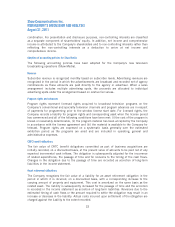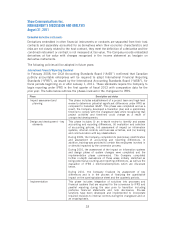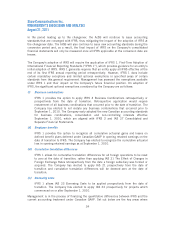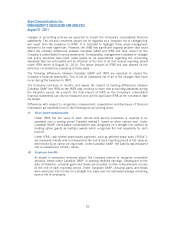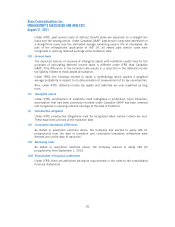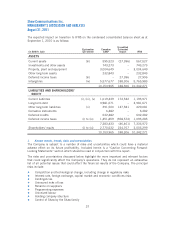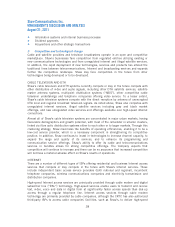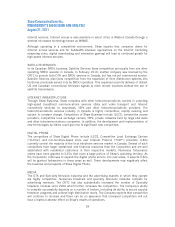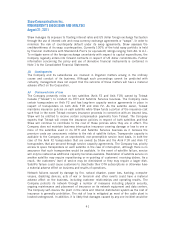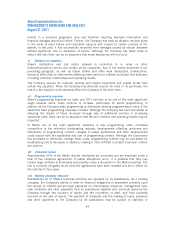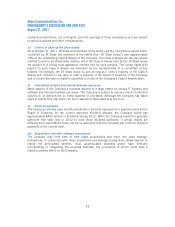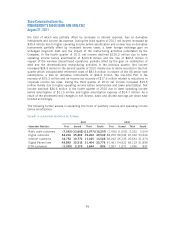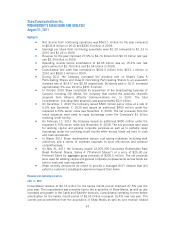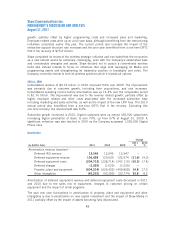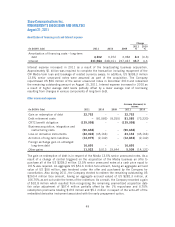Shaw 2011 Annual Report Download - page 43
Download and view the complete annual report
Please find page 43 of the 2011 Shaw annual report below. You can navigate through the pages in the report by either clicking on the pages listed below, or by using the keyword search tool below to find specific information within the annual report.Shaw Communications Inc.
MANAGEMENT’S DISCUSSION AND ANALYSIS
August 31, 2011
Internet services. Internet access is also available in select cities in Western Canada through a
wireless microwave technology known as WiMAX.
Although operating in a competitive environment, Shaw expects that consumer desire for
Internet access services and for bandwidth-intensive applications on the Internet (including
streaming video, digital downloading and interactive gaming) will lead to continued growth for
high-speed Internet services.
SATELLITE SERVICES
In its Canadian SRDU business, Satellite Services faces competition principally from one other
operating SRDU operator in Canada. In February 2010, another company was licensed by the
CRTC to provide both DTH and SRDU services in Canada, but has not yet commenced service.
Satellite Services also faces competition from the expansion of fibre distribution systems into
territories previously served only by SRDU operators. This expansion permits delivery of distant
US and Canadian conventional television signals to more remote locations without the use of
satellite transmission.
INTERNET INFRASTRUCTURE
Through Shaw Business, Shaw competes with other telecommunications carriers in providing
high-speed broadband communications services (data and video transport and Internet
connectivity services) to businesses, ISPs and other telecommunications providers. The
telecommunications services industry in Canada is highly competitive, rapidly evolving and
subject to constant change. Competitors of Shaw Business include ILECS, competitive access
providers, competitive local exchange carriers, ISPs, private networks built by large end users
and other telecommunications companies. In addition, the development and implementation of
new technologies by others could give rise to significant new competitors.
DIGITAL PHONE
The competitors of Shaw Digital Phone include ILECS, Competitive Local Exchange Carriers
(“CLECs”) and non-facilities-based Voice over Internet Protocol (“VoIP”) providers. ILECs
currently control the majority of the local telephone services market in Canada. Several of such
competitors have larger operational and financial resources than the Corporation and are well
established with residential customers in their respective markets. Numerous forbearance
orders have been granted to ILECs that cover a large portion of Shaw’s operating territory. As
the Corporation continues to expand the digital phone service into new areas, it expects ILECs
will be granted forbearance in those areas as well. These developments may negatively affect
the business and prospects of Shaw Digital Phone.
MEDIA
The OTA and Specialty television business and the advertising markets in which they operate
are highly competitive. Numerous broadcast and specialty television networks compete for
advertising revenues. The CRTC has also substantially increased the number of Specialty
television licenses since 2000 which further increases the competition. The Company’s ability
to compete successfully depends on a number of factors, including its ability to secure popular
television programs and achieve high distribution levels. The Company expects that competition
will continue to increase and there can be no assurance that increased competition will not
have a material adverse effect on Shaw’s results of operations.
39





